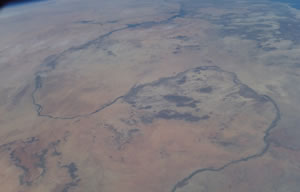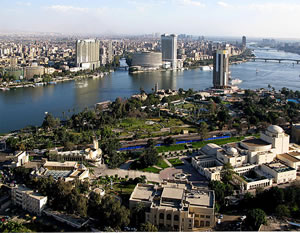The Nile is the longest river in the world, flowing northwards through Africa until it empties into the Mediterranean Sea.
The Nile is made up of two rivers, the White Nile and the Blue Nile, which merge at Khartoum in Sudan. The total course of the White Nile, together with the Nile flowing through Egypt, is 6,695km (4,160mi).
From the northern end of Lake Victoria, the waters of the White Nile flow through open scrubland and then tumble 37m (120ft) over the Murchison Falls. The river hurries down to the marshy plain known as the Sudd, an all but impenetrable papyrus and lotus swamp covering around 650,000sq.km (251,000 sq.mi).
 Below the Sudd, the White Nile becomes broad and stately as it winds its way through barren lands to Khartoum, the capital of Sudan. Here it joins the Blue Nile, so named because its waters are indeed blue; those of the White Nile are, at this juncture, pale green.
Below the Sudd, the White Nile becomes broad and stately as it winds its way through barren lands to Khartoum, the capital of Sudan. Here it joins the Blue Nile, so named because its waters are indeed blue; those of the White Nile are, at this juncture, pale green.
As it crosses the Nubian Desert to the north of Khartoum, the Nile cascades over four cataracts before flowing into Lake Nasser, known as Lake Nubia in Sudan. This lake was formed by the Aswan High Dam, which was completed at Sadd al Aafi, near Aswan, in 1971.
Flooding of the Nile
Every summer, rainfall and melting snows swell the Nile and cause the annual floods that inundated Egypt until the Aswan Dam was built in the 20th century.
Farmers who settled along the banks of the lower Nile around 7,000 years ago planted crops in the fertile silt left after the Nile's flood had retreated.
 These farmers came to worship the river as a god, whom they named Hapi. A statue in the Vatican Museum in Rome depicts a reclining Hapi clutching ears of corn and surrounded by 16 children, each a cubit in height. The statue symbolized a warning: should the Nile flood fail to reach the height of 16 cubits, around 7.5m (25ft), there would be a famine.
These farmers came to worship the river as a god, whom they named Hapi. A statue in the Vatican Museum in Rome depicts a reclining Hapi clutching ears of corn and surrounded by 16 children, each a cubit in height. The statue symbolized a warning: should the Nile flood fail to reach the height of 16 cubits, around 7.5m (25ft), there would be a famine.
The annual flooding of the Nile enable the ancient Egyptians to grow enough food to eat and eventually, to establish their great empire.
The Blue Nile contributes four fifths of the floodwater that floods Egypt. Although the White Nile has a much larger huge catchment area, much of its water is lost in the swamps of southern Sudan.